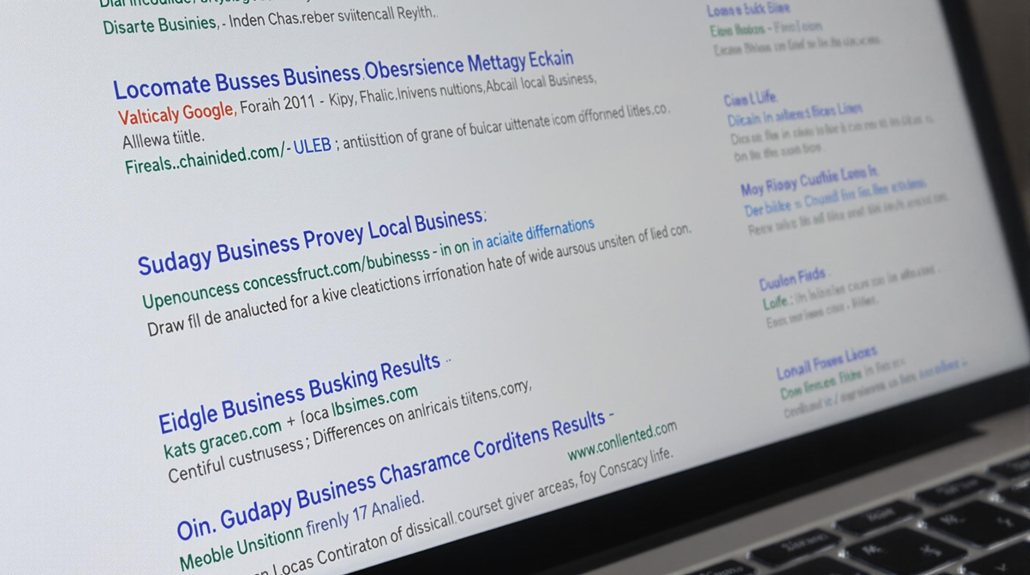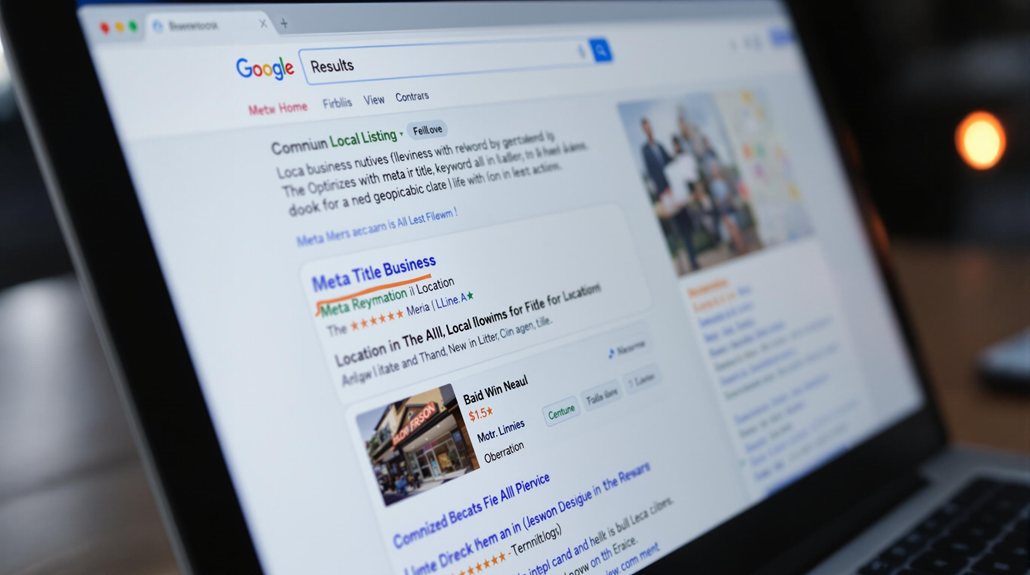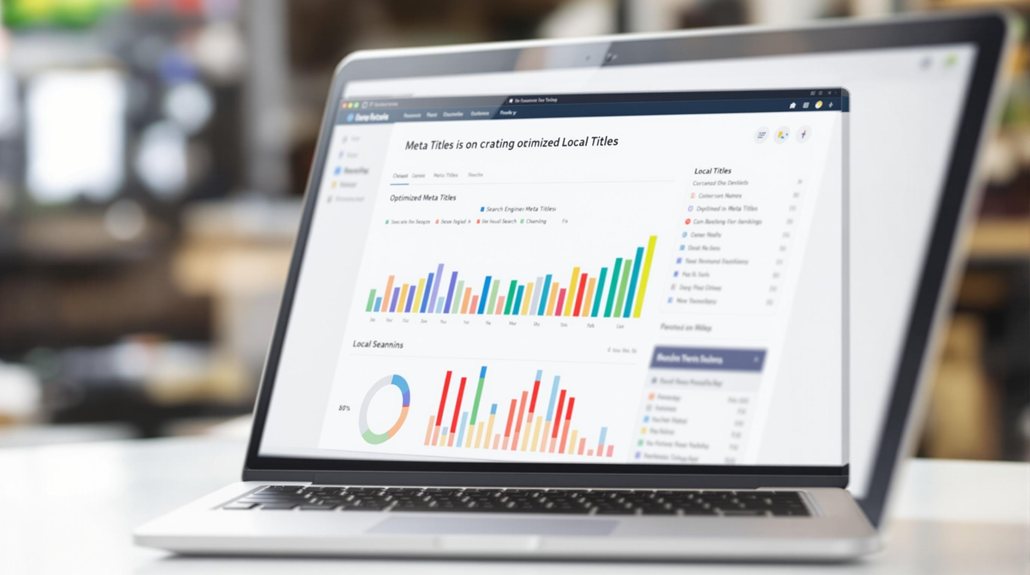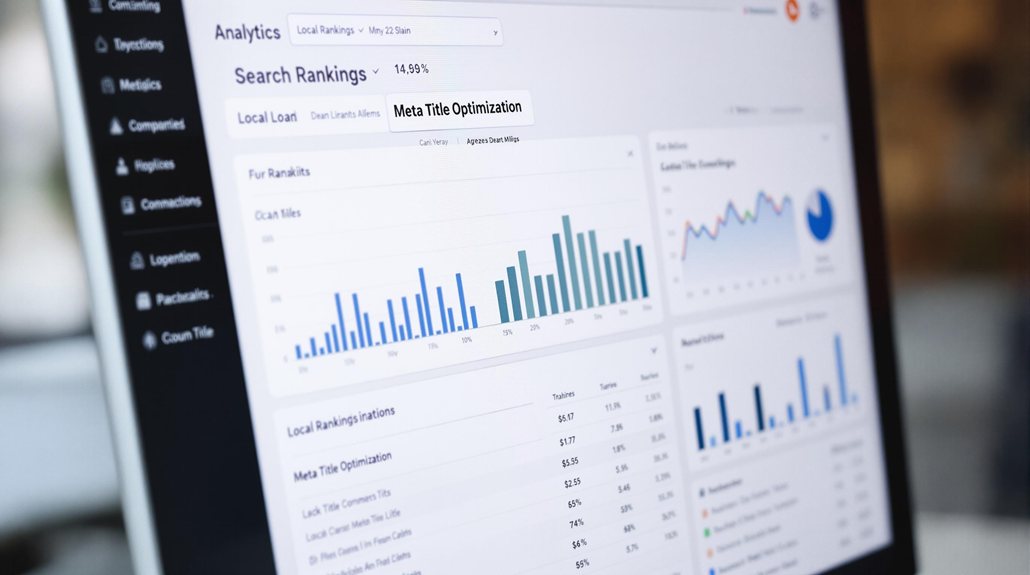Optimizing your meta titles is essential for boosting your local rankings. Start by identifying relevant local keywords using specialized tools. Craft attention-grabbing titles that incorporate your location, primary keywords, and unique selling points. Structure your titles for maximum impact, keeping them concise and consistent across your site. Ensure local relevance by including geographic cues and consistently using location-specific keywords. By following these strategies, you'll be well on your way to improving your local visibility and attracting more customers. For a deeper dive into local SEO optimization, let's explore the next steps.
Importance of Optimizing Meta Titles for Local Rankings

The meta title is a critical component of your local SEO strategy. It plays a pivotal role in search engine results pages (SERPs), where it serves as the first point of interaction with potential customers. Crafting a compelling meta title that includes your target keyword and location can significantly boost your page's visibility, encouraging clicks from nearby searchers. Moreover, well-designed titles reflect your business's credibility and help set user expectations, positively impacting engagement metrics that can indirectly influence your SEO performance. Meta titles are a key factor in determining page relevance to search queries. Optimizing your meta titles is a straightforward yet impactful way to enhance your local online presence and drive more qualified traffic to your website.
Identifying Relevant Local Keywords

Leverage local keyword tools to uncover terms your audience uses. Keywords are a fundamental element of search engine optimization (SEO). Localize existing keywords by incorporating location-specific modifiers. Analyze competitor titles to identify opportunities in your local market. Additionally, search engine algorithms consider keyword prevalence as a major ranking factor, so targeting local keywords can increase visibility and attract more organic traffic.
Leverage Local Keyword Tools
Identifying the right local keywords is crucial for boosting your website's visibility in localized search results. Leverage powerful tools like:
- Semrush's Keyword Magic Tool to uncover insights on local keywords and filter by location.
- KWFinder for detailed data on local search volumes and keyword difficulty.
- Google Keyword Planner to identify relevant keywords with high demand.
- Ahrefs to analyze your competitors' keywords and discover untapped opportunities.
- Ubersuggest to help you discover trending local keywords and competitor strategies.
Local SEO is vital for businesses targeting specific geographic areas. These tools provide the data you need to optimize your meta titles and other on-page elements for maximum local impact. With the right local keywords in place, you can attract more qualified traffic and improve your chances of ranking higher in local search.
Localize Existing Keywords
Localizing existing keywords is a crucial step in enhancing your website's visibility for local search. By identifying relevant local keywords, you can target specific locations and improve your online presence. Analyze search volume and competition to prioritize effective keywords, utilizing tools like Google Keyword Planner or Semrush. Incorporate location modifiers, such as city or neighborhood names, to optimize for local search intent. Structure your keywords by combining your main topic with a location, like "Los Angeles yoga classes." Evaluate local search metrics to select keywords with high volume and manageable difficulty. Strategically place these localized keywords in your content, including titles, meta descriptions, and headings, to improve your SEO and user engagement. Additionally, consider incorporating long-tail keywords to target specific user queries and capture more qualified traffic.
Analyze Competitor Titles
Analyzing your competitors' titles can reveal valuable insights for identifying relevant local keywords. Use tools like Ahrefs, SEMRush, and SEOptimer to research your top competitors' strategies. Examine how they incorporate local keywords into their meta titles and descriptions. Look for gaps in their approach that you can capitalize on.
- Identify high-ranking competitors in your local area by searching Google and examining local directories.
- Determine which keywords drive traffic to their websites and assess their use of long-tail keywords.
- Evaluate the structure and appeal of their meta titles and descriptions for local visibility.
- Understand the competitive landscape and keyword demand in your market.
- Analyze how competitors adjust their strategies for local SEO success.
Understanding your competitors' local SEO strategies can provide valuable insights for optimizing your own meta titles.
Crafting Attention-Grabbing Meta Titles

Crafting attention-grabbing meta titles is crucial for local businesses seeking to stand out in search engine results. Incorporate location keywords to target local audiences, and include primary and secondary keywords to improve rankings. Keep the title concise, under 60 characters, and use numbers or power words to evoke emotions and attract clicks. Emphasize your local expertise or unique offers to build trust and differentiate your business. Integrate keywords naturally without appearing spammy, and leverage creative elements like special characters or questions to increase visibility. Optimize meta titles for mobile devices to ensure visibility across all platforms. Optimize for mobile, review titles regularly, and test different variations to determine the best-performing ones.
Structuring Meta Titles for Maximum Impact
Structuring your meta titles for maximum impact is crucial for boosting your local rankings. Strive to keep your titles concise, under 60 characters, with your primary keyword upfront. Ensure each title is unique to avoid cannibalization. Leverage tools like Yoast SEO to optimize and automate your meta title creation. Consider including your brand name to build recognition.
Use trigger words to attract clicks, such as:
- Emotional: "Get," "Try," or "Exclusive"
- Urgency: "Limited Time," "Last Chance," or "Hurry"
- Educational: "Learn," "Grow," or "Discover"
- Promotional: "Special Offer," "Free," or "Guarantee"
Align your titles with the page's content and user intent for maximum relevance and engagement. Enterprises combat two main issues: cannibalization and uniqueness when creating meta titles.
Ensuring Local Relevance in Meta Titles
Optimizing your meta titles for local relevance is paramount. Incorporate location-specific keywords like city or region names to enhance search visibility. Use geographical cues like “Near [City]” to indicate proximity. Include local landmarks or features to further differentiate your business. Ensure consistency in location keywords across all meta tags. Utilize tools like Google Keyword Planner to identify local search trends.
Understand user search intent and tailor your meta titles accordingly. Include keywords related to local services or products, and ensure your meta titles reflect the type of business you offer. Keep your meta titles under 55 characters for optimal display. Leverage geographical indicators like zip codes, area codes, and state or province names to specify your service area. Regularly monitor and analyze the performance of your location-specific meta titles to optimize your local visibility strategy.
Incorporating Unique Selling Points in Meta Titles
Incorporating unique selling points into your meta titles can be a powerful way to differentiate your business and capture the attention of local searchers. By highlighting what sets your business apart, you can entice users to click through to your website. Consider incorporating:
- Certifications and awards that showcase your expertise
- Exclusive offers or deals not available elsewhere
- Advanced technology or innovative services
- Testimonials from satisfied customers
- Free services or consultations to demonstrate value
Adding location to the title tag helps the title tag appear in local search results.
Leveraging Geo-Targeting for Local Visibility
Geo-targeting can be a game-changer when it comes to enhancing your local business's visibility. By incorporating location-specific keywords into your meta titles, you can significantly improve your search rankings and attract more targeted local traffic. Conduct thorough keyword research to identify the most relevant geo-modifiers, and use them naturally in your titles to showcase your location. Dynamically tailored content makes it more relevant and interesting to individual users. Remember to maintain consistency across your website, and integrate geo-modifiers into your content, URL structure, and header tags. Additionally, leverage schema markup and local directory listings to further solidify your local relevance. Regularly monitor your performance to refine your geo-targeting strategies and maximize their impact on your local rankings and traffic.
Tools and Techniques for Keyword Research
Conducting thorough keyword research is paramount when it comes to enhancing your local business's visibility online. Leverage powerful tools like Ahrefs, SEMrush, and KWFinder to uncover location-specific keywords, analyze competitor strategies, and optimize your content accordingly. These tools offer:
- Location-based search volumes to target the right audience
- Long-tail keyword identification for less competitive opportunities
- Competitor analysis to stay ahead of the curve
- Language support for multilingual regions
- SERP analysis to understand the competitive landscape
Utilize these features to find the most relevant local keywords, integrate them seamlessly into your meta titles and descriptions, and drive targeted traffic to your website.
Adhering to Meta Title Length Limitations
When crafting meta titles, you'll need to keep an eye on length limitations. While common guidelines suggest titles under 60 characters, you can actually extend them up to 600 pixels without truncation concerns. However, prioritize readability over sheer length – overly long titles may deter clicks despite meeting technical requirements.
Ideal Title Length
Although meta title guidelines suggest an ideal length of around 50-60 characters, you'll want to focus on the pixel width rather than just the character count. Meta titles should ideally fit within a width of about 600 pixels for desktop and 512 pixels for mobile devices. Keep in mind that:
- Titles may display fully on mobile even beyond traditional character limits due to longer display lines.
- Key information and keywords should be placed at the beginning of the title.
- Title display can vary significantly between desktop and mobile devices.
- Titles are measured in pixels rather than characters due to font width variability.
- A well-structured title within recommended limits can improve click-through rates.
Exceeding Character Limits
While Google prioritizes pixel width over character count when displaying titles in search engine results pages (SERPs), it's important to understand the implications of exceeding traditional title length limitations. Truncation can affect click-through rates and user perception, so it's crucial to strategize. Place important keywords early, adapt for mobile versus desktop, and consider including your brand name. Ultimately, optimize titles for user experience, not just SEO. Leverage local keywords, compelling language, and unique titles to boost visibility in local search. Remember, Google values content quality and user interaction, so strive for meaningful keyword integration and responsive design across devices.
Truncation Consequences
Exceeding title length limits can have serious consequences. Truncated titles often fail to convey the complete message, reducing their effectiveness. Lower click-through rates (CTRs) can influence search engine rankings indirectly, as users are less likely to click on titles that appear incomplete or less compelling. Proper title length management is essential for effective SEO. Consider these strategies to avoid truncation:
- Use tools to test title lengths against SERP displays
- Focus on essential information at the start of the meta title
- Ensure titles accurately describe page content
- Test different title lengths to optimize for various devices
- Integrate your brand strategically
Optimizing meta titles for local rankings requires clear and concise titles that highlight local relevance and avoid truncation.
Aligning Meta Titles With Page Content
Aligning your meta titles with the content on your webpage is crucial for effective search engine optimization (SEO). Accurately represent your page's main topic, using relevant keywords and clear language. Maintain consistency in formatting and language across your site. Optimize for keywords by placing the primary one at the beginning of the title. Consider technical details like character limits and mobile optimization. For local SEO, include location-specific keywords without redundancy.
| Accurate Representation | Ensuring Consistency | Keyword Optimization |
|---|---|---|
| Reflect content precisely | Language consistency | Primary keyword placement |
| Avoid misleading titles | Format consistency | Secondary keywords |
| Relevant keywords | Template use | Keyword relevance |
Improving Click-Through Rates With Optimized Titles
Your meta title is the first thing users see in search engine results, so optimizing it is crucial for improving click-through rates (CTR). Incorporate relevant keywords to enhance visibility, but avoid keyword stuffing. Aim for an optimal length of around 60 characters to ensure full SERP display. Use action words or calls to action to encourage clicks, and consider evoking emotions or curiosity to entice users. Reflect your brand's unique personality to stand out. Additionally, leveraging parentheses or brackets can provide context and increase curiosity without cluttering the main title. Ultimately, strive for clarity, concision, and a visually appealing hierarchy to build user trust and engagement.
- Incorporate relevant keywords without keyword stuffing
- Aim for an optimal title length of around 60 characters
- Use action words or calls to action to encourage clicks
- Evoke emotions or curiosity to entice users
- Leverage parentheses or brackets to provide context
Measuring the Impact of Meta Title Optimization
To measure the impact of meta title optimization, you'll want to track key metrics like click-through rates and search engine rankings. Analyze data from tools like Google Analytics to understand how your optimized titles are performing and identify areas for improvement. Ongoing monitoring and adjustments to your meta titles can help boost your local visibility and drive more qualified traffic to your site.
Metrics for Evaluating Success
Evaluating the success of meta title optimization requires a multi-faceted approach. By tracking key metrics, you can gauge the impact of your efforts and refine your strategies accordingly. Consider the following:
- Website Traffic Analysis: Monitor changes in site visitors, traffic sources, and trends over time to understand the influence of meta title optimization.
- Search Engine Position Tracking: Analyze ranking performance for target keywords across different search engines to assess the effectiveness of your meta title strategies.
- Local Search Visibility Metrics: Evaluate local search impressions, clicks, and directory consistency to measure the impact on local search visibility.
- Conversion Rate Monitoring: Track conversions and compare performance between meta title variations to understand their effect on user behavior.
- Competitor Analysis Metrics: Benchmark your performance against local competitors to identify areas for improvement.
Tracking Click-Through Rates
Tracking click-through rates (CTR) is crucial for measuring the impact of your meta title optimization efforts. An increase in CTR can significantly boost your website's traffic and engagement. Properly optimized titles can increase CTR by up to 8.9%. Titles with emotional resonance outperform those with traditional power words by 7%.
| Tool | Benefit |
|---|---|
| Google Search Console | Track CTR and impressions |
| SERP analysis | See how meta titles appear |
| A/B testing | Compare title versions |
| Rank tracking | Monitor position changes over time |
| Device-specific data | Adjust titles accordingly |
Keeping your titles short (15-40 characters), focused on a single primary keyword, and aligned with your page content will ensure optimal CTR and engagement.
Optimizing for Higher Rankings
While optimizing your meta titles is crucial for local search engine rankings, it's essential to measure the impact of your efforts. Closely monitor changes in your search engine rankings after making improvements to your meta titles. Track the performance of your target keywords included in the titles. Observe increases in website traffic as an indicator of successful optimization. Compare your traffic and rankings with your competitors to gauge the effectiveness of your meta title strategy. Utilize SEO tools to gather data on user interaction with your optimized titles. By closely measuring the impact of your meta title optimization, you can refine your approach and ensure your local SEO efforts deliver the desired results.
- Monitor ranking improvements
- Track keyword performance
- Observe traffic increases
- Compare with competitor data
- Leverage SEO tool insights
Integrating Local SEO Elements in URL Structure
Integrating local SEO elements into your URL structure can be a powerful way to signal geographical relevance to search engines. Choose keywords related to your business location, and include them in your URLs, like "www.yourbusiness.com/denver-plumbing-services". Keep your URLs concise and straightforward, using hyphens to separate words. Optimize your URL structure by aligning it with local search intent, creating location-specific landing pages, and ensuring keyword relevance. Use best practices like adequate length, avoiding dynamic parameters, and incorporating schema markup. For businesses with multiple locations, structure your URLs to target each area specifically, and consider using country-specific domains or local language if expanding internationally. Maintain consistent geographical focus across your site's content and structure.
Enhancing Meta Description Optimization for Local Relevance
Crafting effective meta descriptions is essential for boosting your local search visibility. By incorporating location-specific keywords, compelling CTAs, and cultural touches, you can signal local relevance and attract more engaged users. Avoid keyword stuffing, and tailor meta descriptions to local search intent for optimal click-through rates.
- Highlight your unique value proposition to differentiate your business.
- Use dynamic meta descriptions for multi-location businesses to increase relevance.
- Leverage structured data to enhance visibility with rich snippets.
- Monitor performance and adjust based on click-through rates in Google Search Console.
- Optimize for mobile to provide a seamless user experience across devices.
Maintaining NAP Consistency Across Online Listings
As a local business owner, maintaining consistent Name, Address, and Phone number (NAP) information across online listings is crucial for improving your local search rankings. NAP consistency helps search engines verify your business's legitimacy, enhancing your visibility across directories. Use advanced tools to monitor and correct any NAP discrepancies, focusing on key listings like Google My Business and Yelp. Implement local schema markup to further improve search engine recognition. Eliminate duplicate listings and ensure your NAP details are easily readable on all devices. Accurate and consistent NAP builds user and search engine trust, leading to higher local SEO rankings and increased foot traffic.
